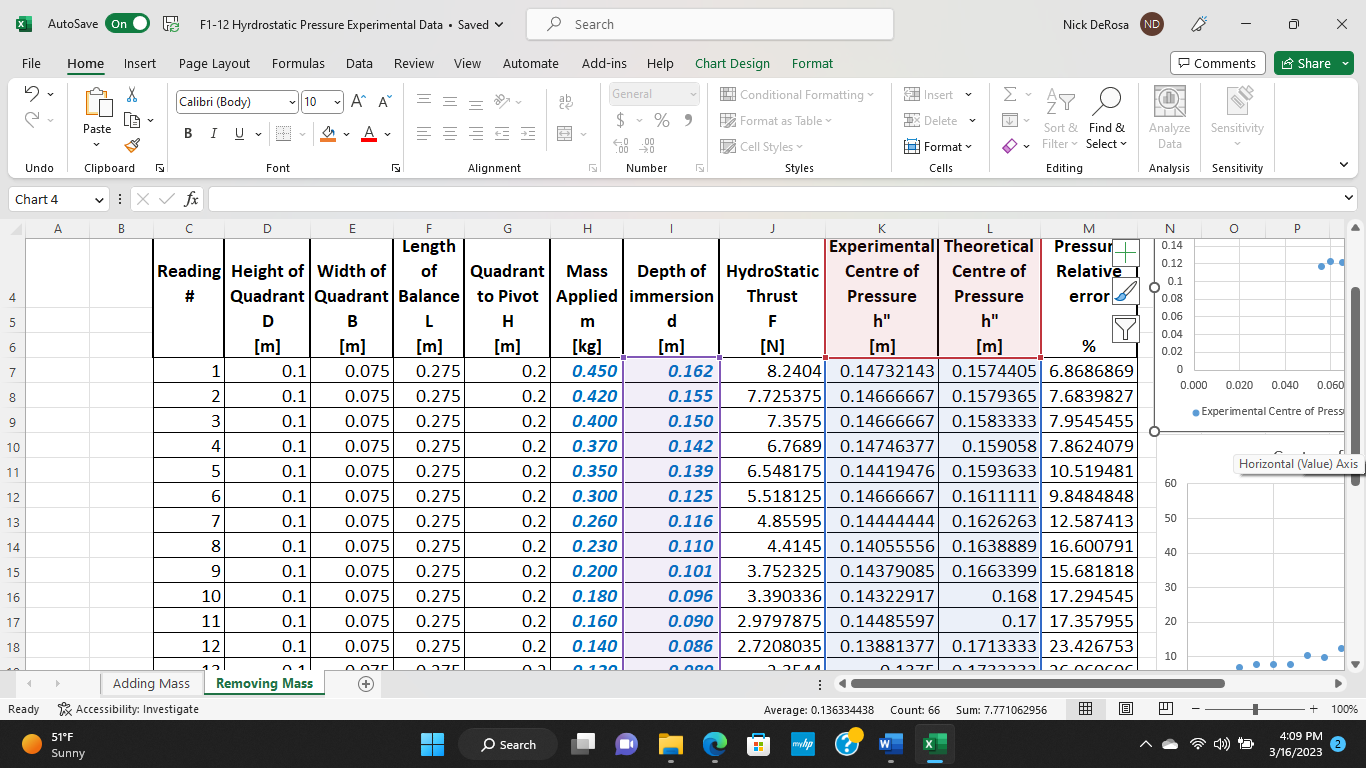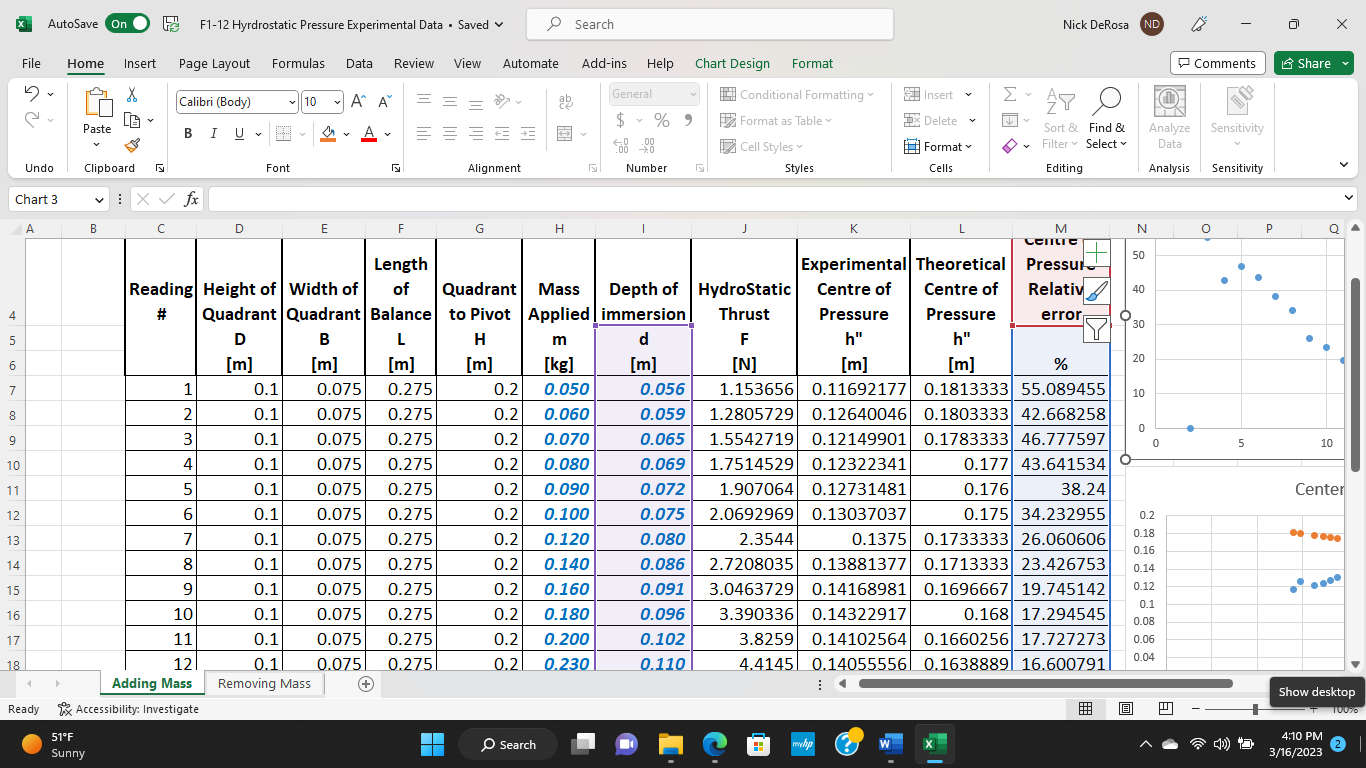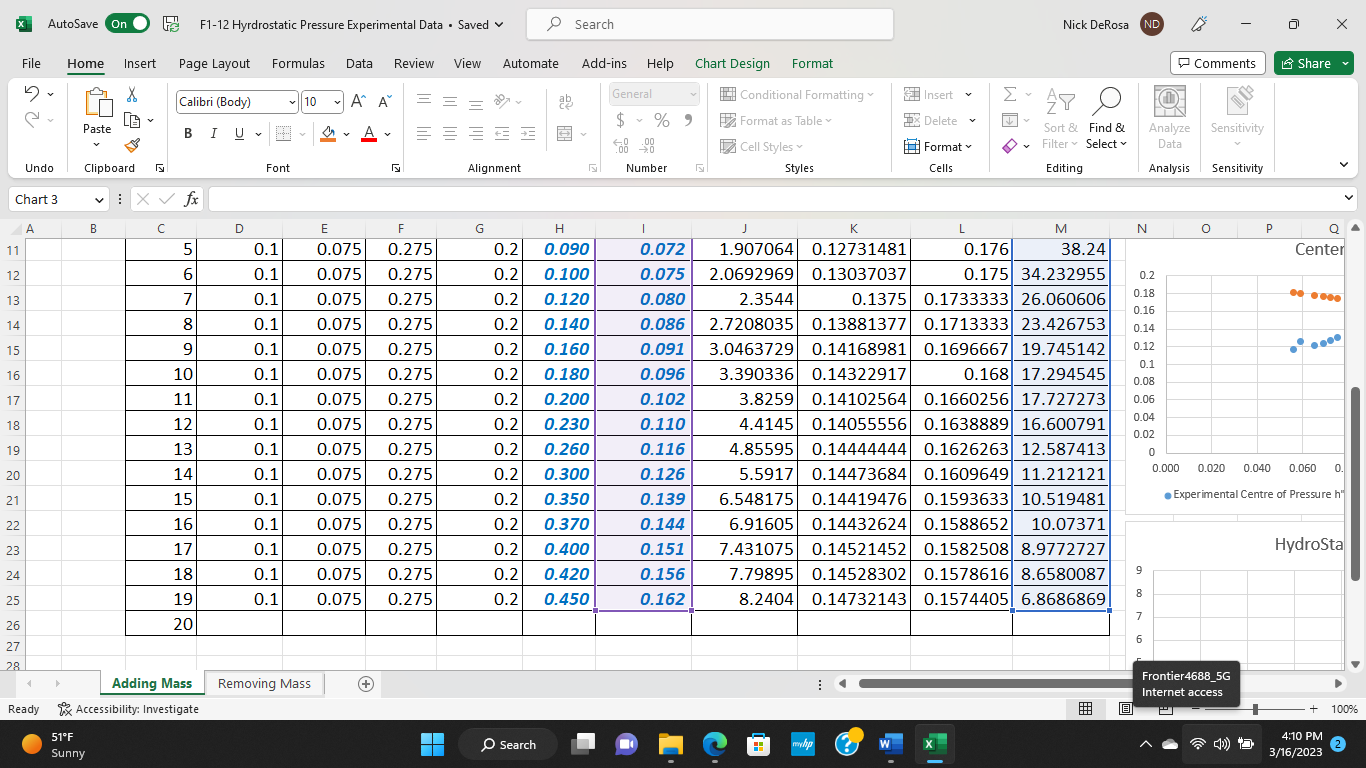Answered step by step
Verified Expert Solution
Question
1 Approved Answer
Comment on the variation of the thrust F with the depth of immersion d . Is this what you expected? Explain why. Comment on the
- Comment on the variation of the thrust F with the depth of immersion d. Is this what you expected? Explain why.
- Comment on the relationship between the experimental depth of the center of pressure and the depth of immersion. Is this what you expected? Explain why.
- For both (1) and (2) above, comment on what happens when the plane has or would have become fully submerged.
- What is the meaning of the center of pressure relative error? What would be the ideal value?
- List and explain all the possible causes of any discrepancies between the experimental and theoretical results for the depth of center of pressure.



AutoSave On F1-12 Hyrdrostatic Pressure Experimental Data Saved Search Nick DeRosa ND File Home Insert Page Layout Formulas Data Review View Automate Add-ins Help Chart Design Format Comments Share General Calibri (Body) 10 v ' ' $ %9 Paste BIU v v v Conditional Formatting Format as Table Cell Styles Insert Delete Sort & Find & Undo Clipboard Font Alignment Number Styles Format Cells Filter Select Analyze Sensitivity Data v Editing Analysis Sensitivity Chart 4 X fx A B C E G H L M N P Length Experimental Theoretical | Pressur 0.14 0.12 Reading Height of Width of of Quadrant Mass 4 # Quadrant Quadrant Balance Depth of to Pivot Applied immersion HydroStatic Thrust Centre of Centre of Relative 0.1 Pressure Pressure error 0.08 5 D B L H m d F h" h" 0.06 0.04 6 [m] [m] [m] E [m] [kg] [m] [N] 7 1 0.1 0.075 0.275 0.2 0.450 0.162 [m] 8.2404 0.14732143 0.1574405 6.8686869 [m] % 0.02 0 0.000 0.020 0.040 0.060 8 2 0.1 0.075 0.275 0.2 0.420 9 3 0.1 0.075 0.275 0.2 10 4 0.1 0.075 0.275 11 5 0.1 0.075 0.275 12 6 0.1 0.075 0.275 13 7 0.1 0.075 0.275 14 8 0.1 0.075 0.275 15 9 0.1 0.075 0.275 16 10 0.1 0.075 0.275 17 11 0.1 0.075 0.275 18 12 0.1 0.075 0.275 0.2 0.2 0.400 0.2 0.370 0.2 0.350 0.2 0.300 0.2 0.260 0.2 0.230 0.2 0.200 0.2 0.180 0.160 0.140 0.155 0.150 0.142 0.139 0.125 0.116 0.110 4.4145 0.14055556 0.1638889| 16.600791 0.101 3.752325 0.14379085 0.1663399 15.681818 0.096 3.390336 0.14322917 0.168 17.294545 0.090 2.9797875 0.14485597 0.17 17.357955 20 0.086 2.7208035 0.13881377 0.1713333 23.426753 7.725375 0.14666667 0.1579365 7.6839827 Experimental Centre of Press 7.3575 0.14666667 0.1583333 7.9545455 6.7689 0.14746377 0.159058 7.8624079 6.548175 0.14419476 0.1593633 10.519481 5.518125 0.14666667 0.1611111 9.8484848 4.85595 0.14444444 0.1626263 12.587413 Horizontal (Value) Axis 60 50 40 30 10 0370 0130 0.000 0.1275 01722222 arnentne Adding Mass Removing Mass Ready Accessibility: Investigate 51F Sunny O Search Average: 0.136334438 Count: 66 Sum: 7.771062956 100% 4:09 PM 3/16/2023
Step by Step Solution
There are 3 Steps involved in it
Step: 1
Solutions Step 1 1 The thrust which is also the hydrostatic force exerted on the beam is greater when it is submerged and less when it is floating Therefore the thrust is directly proportional to the depth Comment on the relationship between the depth of the center of pressure and the depth of immersion The increase in depth of the immersion of the body causes an increase in the depth of its center of pressure This is only true when the center of pressure relative to the beam remains constant Thus the depth of of pressure is directly proportional to the depth of immersion of the beam For both 1 and 2 comment on what happens when the plane has become fully submerged When the plane has become fully submerged in the liquid an increase in pressure is experienced due to its high depth Also since hydrostatic pressure which is affected by depth is also relative to hydrostatic force there will be an increase in the hydrostatic force Explanation The thrust or hydrostatic force on a submerged beam is directly proportional to the depth resulting in greater force when submerged and less when floating The ...
Get Instant Access to Expert-Tailored Solutions
See step-by-step solutions with expert insights and AI powered tools for academic success
Step: 2

Step: 3

Ace Your Homework with AI
Get the answers you need in no time with our AI-driven, step-by-step assistance
Get Started


